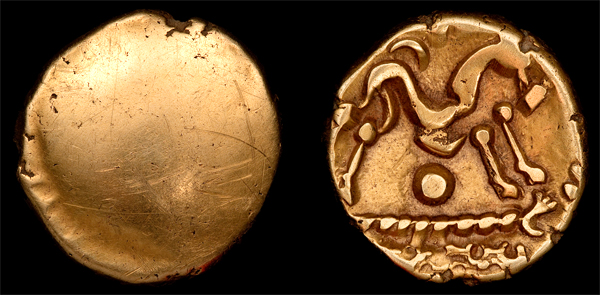
Unique ID: 78
The GB-E staters, commonly known as Ambiani uniface or Gallic War staters, were minted between 58 BC and 50 BC by a coalition of Belgic tribes who were at war with Caesar. The first coins die link to the GB-Ca staters which were minted by the Ambiani, so the GB-E staters are assigned to them. However, producing them was likely to have been a team effort.
They form possibly the the largest series of coins ever minted by the Celts. At the time of writing (2020) there are 1,019 known reverse dies, and over 2,100 known coins, leading to an estimate of 2,314 reverse dies (technically, somewhere between 1,778 and 3,318 dies, with 95% confidence). Assuming that one die could make 1,000 coins, the total production would have been around 2.3 million coins. It would take around 8,330Kg of gold to mint Gallo-Belgic E and it was unlikely that the Ambiani could manage this on their own, even if they recalled all of the Gallo-Belgic Ca coins and melted down their treasure reserves. The uniface design, whereby the obverse is blank, also suggests they were minted by a coalition of tribes. While it’s possible it was left blank to save time cutting dies, they could have saved even more time by leaving just the reverse blank, or even both sides blank, so it’s not a clear cut issue. The coins from late in the war, when the coalition was reduced in size through defeats, started to get small obverse designs, which would have been unlikely if production efficiency was the reason for the earlier ones being blank.
GB-E staters break down into seven distinct classes which are thought to match the seven winters of the Gallic Wars, when coins might have been struck to finance the upcoming year’s hostilities. This coin is part of class 4H, and is thought to be from the winter of 55 and 54 BC.
For such a large and important series of coins, there’s surprisingly very little in the way of literature about them. The most useful is a five page article by Dr. John Sills called “Identifying Gallic War Uniface Staters”, which was published in Chris Rudd List 83 (2005). This is where he defines the classes and gives tips on how to work out which class a coin belongs to. He talks a little about Gallo-Belgic E in Gaulish and Early British Gold Coinage, but only in the context of Gallo-Belgic C. He also discusses them briefly again in Divided Kingdoms: The Iron Age Gold Coinage of Southern England.
This is one of three GB-E staters (of any class) in my collection (see 65 and 66)
